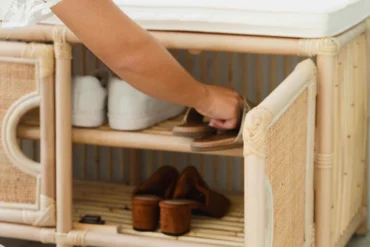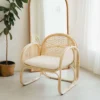Step into a sun-drenched room filled with woven chairs and basket lights, and chances are, you’re surrounded by rattan. But what exactly is rattan? And why has this humble plant become a symbol of laid-back luxury, sustainability, and timeless design?
Let’s explore rattan—not just as a material, but as a living, growing story that spans continents, cultures, and centuries. Whether you’re a design lover, eco-conscious shopper, or just curious, this guide will give you a complete, satisfying understanding of rattan.
What Is Rattan? (The Botanical Truth)

Rattan is a type of climbing palm that thrives in the tropical forests of Southeast Asia—particularly in Indonesia, Malaysia, the Philippines, and parts of Sri Lanka and India. It belongs to the subfamily Calamoideae and includes over 600 species. Unlike typical trees, rattan doesn’t grow upright. Instead, it stretches and climbs through the forest canopy, often using thorns to cling to other vegetation as it searches for sunlight.
These palms can grow incredibly long—some species like Calamus manan reach lengths of over 100 meters. The canes, or stems, are lightweight, durable, and flexible, making them ideal for crafting furniture and home decor. When fresh, rattan emits a faint grassy scent and reveals subtle natural color variations—hints of the lush forest it grew in.
Natural vs. Synthetic: Understanding the Types of Rattan

There are two main categories of rattan used in furniture and design: natural rattan and resin (synthetic) rattan. Each offers unique characteristics suited to different purposes.
Natural rattan is harvested directly from the vine, then dried, treated, and sorted. It is processed into several forms based on its parts. Pole rattan refers to the thick stems, which are used for structural frames. The inner core is stripped into thinner pieces for weaving, often referred to as reed or core rattan. The outer bark, when peeled and smoothed, becomes cane—typically used for wrapping joints or decorative weaving. Natural rattan is prized for its texture and warm appearance, and because it is biodegradable, it is often chosen by those who value eco-friendly materials. However, it is sensitive to prolonged exposure to moisture and direct sunlight, so it’s best suited for indoor use or covered outdoor spaces.
Resin rattan, by contrast, is a synthetic material made from high-density polyethylene (HDPE). It is manufactured to mimic the look of natural rattan but is engineered to withstand rain, humidity, and strong sunlight. It is commonly used in outdoor furniture because it is more durable and resistant to the elements. While it lacks the warmth and variation of real rattan, it requires less maintenance and is easier to clean. Some versions of resin rattan are even recyclable, offering a low-maintenance yet environmentally mindful alternative. One resort owner in Bali noted that switching to resin rattan extended the life of their outdoor lounges by three rainy seasons.
What’s the Difference Between Rattan and Wicker?

This is one of the most common questions—and the source of much confusion. Rattan is a material, while wicker is a weaving technique. Wicker refers to the traditional method of weaving materials—such as rattan, willow, bamboo, or synthetic fibres—into furniture and objects. So, a “wicker chair” might be made from rattan, but it could also be made from another flexible material. Rattan is often used in wicker furniture, but not all wicker furniture is made of rattan. Put simply, if rattan is the thread, wicker is the way that thread is woven.
The Journey from Forest to Furniture
Natural rattan undergoes an extensive process before it becomes the furniture we recognise. First, it is harvested from the forest by skilled workers who cut the canes at the base and transport them through dense vegetation. These canes are then cured—either dried in the sun or smoked or boiled—to eliminate moisture and insects. Once cured, the outer bark is peeled away to produce cane, and the inner core is cut into splits for weaving.
After processing, the material enters the hands of local artisans. The canes are steamed and bent into the desired shapes, then woven, knotted, and fastened using traditional techniques passed down through generations. These artisans work in small workshops or family compounds, many of which are based in rural communities throughout Indonesia, the Philippines, and Vietnam. In towns like Cirebon, Indonesia, entire families are involved in rattan craft. Each piece they create tells a story—not only of material transformation, but of skill, patience, and cultural continuity.
The survival of rattan craftsmanship depends on continued demand for handmade furniture and fair support for local makers. When consumers choose authentic, artisan-crafted rattan over mass-produced alternatives, they help preserve a centuries-old tradition. It’s more than buying furniture—it’s helping ensure that an entire art form, and the livelihoods it sustains, are not lost to time or automation.
Sustainability and the Ethics of Rattan
One of rattan’s greatest strengths lies in its sustainability. It grows rapidly—some species increase in length by up to two centimetres a day. Because it thrives in forested environments, harvesting rattan does not require deforestation. In fact, sustainable rattan harvesting can help preserve forests, providing communities with an economic incentive to protect rather than clear land. However, not all rattan is harvested ethically. Some supply chains lack transparency, and overharvesting in certain regions has led to ecological stress.
For consumers, it’s important to look for rattan certified by organisations such as the Forest Stewardship Council (FSC) or the Programme for the Endorsement of Forest Certification (PEFC). These labels ensure that harvesting practices are environmentally sound and socially responsible. Cooperative programs in places like Kalimantan and Sabah offer traceable sourcing that directly benefits indigenous communities. Choosing verified rattan isn’t just about quality—it’s a vote for sustainable livelihoods and long-term forest preservation. Compared to plastic or metal furniture, the carbon footprint of responsibly sourced rattan is significantly lower, especially when paired with ethical production practices.
Cultural and Historical Significance

Rattan has played a central role in everyday life for many Asian cultures for centuries. It has been used to make baskets, mats, tools, and household goods—items woven not just for function but often with symbolic patterns or ceremonial use. In the Philippines, rattan was traditionally used in ancestral rituals and to craft protective amulets. During the colonial era, European settlers adopted rattan for its lightweight and ventilated properties, making it ideal for use in tropical environments.
By the 20th century, rattan had become popular worldwide. In the 1960s and 70s, it was embraced in Western design for its relaxed, bohemian vibe. Designers like Paul Frankl and Franco Albini helped elevate rattan furniture from tropical decor to global design staple. Today, rattan continues to appeal to a wide audience, with its natural warmth and timeless appeal fitting seamlessly into both modern and traditional interiors.
Why Rattan Furniture Is Still So Popular
Rattan’s enduring popularity is not just a matter of style—it also reflects deeper values. It embodies a return to natural materials, handmade processes, and slower living. Rattan furniture adds warmth and texture to a space, creating an inviting and tactile environment. It is versatile and adaptable, working equally well in minimalist, rustic, coastal, and even industrial designs. Its sculptural quality allows it to be shaped into both classic and contemporary forms, from peacock chairs and pendant lights to sleek coffee tables and bed frames.
Interior designer Mei Lin Lee describes rattan as “an emotional material—it softens a space with its curves and stories.” The familiarity of rattan evokes memories of childhood homes, seaside holidays, or a favourite café. For many, it offers not just aesthetic appeal but a sense of calm and comfort, making it ideal for modern wellness-oriented interiors.
How to Care for Rattan (Natural and Resin)
Caring for natural rattan requires mindfulness. It should be kept in indoor environments or shaded outdoor spaces to avoid damage from rain and sun. Cleaning should be done using a dry or lightly damp cloth, as soaking the material can lead to warping. Dusting regularly with a soft brush can help maintain its texture and colour. To prevent the fibres from drying out and cracking, an annual application of linseed oil or beeswax polish can keep the cane supple and looking fresh.
Resin rattan is far easier to maintain. It can be hosed down or wiped clean with mild soapy water, making it ideal for outdoor use. However, it’s important to avoid harsh chemicals or abrasive scrubbers, which could damage the synthetic fibres. Storing cushions separately and covering furniture during extreme weather can also extend its life.
Final Thoughts: More Than Just a Pretty Weave
Rattan is more than a visual trend—it’s a deeply rooted material that carries centuries of tradition, culture, and craftsmanship. Whether you’re drawn to its sustainable properties, its tactile beauty, or its cultural legacy, rattan offers something truly enduring. From forest vine to finished form, it connects us to nature, to people, and to a slower, more intentional way of living.
So the next time you admire a woven chair or basket, take a moment to appreciate not just how it looks—but everything it represents. Within each curve is a story: of a vine climbing toward light, of skilled hands shaping form from fibre, and of a tradition that continues to grow and adapt with us.


